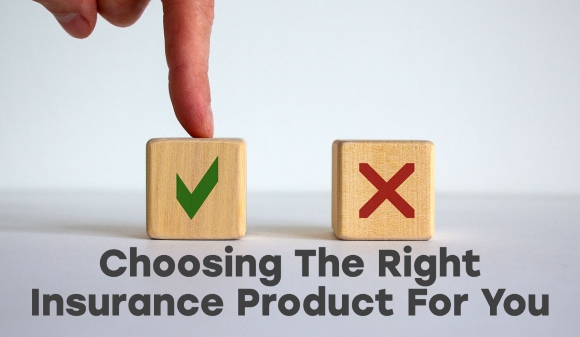Choosing The Right Insurance Product For You

 When looking to obtain life insurance, there are two questions you need to ask yourself.
When looking to obtain life insurance, there are two questions you need to ask yourself.
1. What type of life insurance should I own?
2. How much life insurance should I own?
Two types of life insurance options are available: Term Life Insurance and Permanent Life Insurance. Within these categories, there are different options to consider.
Term Life Insurance
Term insurance, as the name suggests, is for a limited period based on product design. Once the initial term expires, the insured can cancel the policy, renew it for another term without medical questions or exams or convert it to a permanent policy without medicals, and conversion is only available through the insurer who issued the original term contract.
When choosing a term policy, always examine what permanent options are available with the insurer should you choose to convert the policy in the future.
The term insurance policy “initially” is less costly due to the restricted coverage period or if you live past the policy’s expiration date. Every term renewal period increases substantially, and the policy is either cancelled or converted to permanent coverage. In the industry, only 1% of term policies pay out a death benefit. Please don’t get me wrong; we have clients with both term and permanent policies, the choice of product is designed to meet their situations.
These are the most utilized term policies we will discuss in this article:
- 10 Year Renewable & Convertible Term
- 20 Year Renewable & Convertible Term
- 30 Year Renewable & Convertible Term
A “renewable” policy continues, but each renewal will be subject to a new, higher premium than when you initially purchased the policy. The advantage is you do not need to complete new medicals, but your premium could increase seven to ten times more than the initial premium.
Rates on renewal of a term policy are guaranteed at a future date. Let me let you in on a little secret that your insurance company will not tell you, nor even your advisor may not tell you: you should contact your advisor before the policy renews (three months prior). Your advisor represents several insurance companies, and you can ask them to apply in the marketplace for a new policy with the same design if you so choose. You will have to prove that you are in good health when you apply and when you get your new premium, often, it will be with a 50% savings. Even though your policy is renewing, nothing prevents you from “shopping” for a new policy and with proof of good health, big premium savings.
Permanent Life Insurance
Permanent life insurance policies are generally known as Whole Life and Universal Life. In comparison, these policies come with an initial higher premium that provides you with the value we will discuss.
Whole Life
This insurance provides you coverage for the duration of your life as long as premiums continue to be paid. This type of policy includes a savings component in the form of a guaranteed cash value. If your policy is a “participating” policy, it will also include the cash value of dividends paid into your policy on the anniversary of your contract. Not all whole life policies are participating policies. The cash value inside the Whole Life policy grows on a “tax deferred” basis. There are ways that you can use these values in future years by a concept called “leveraging” and not being taxed from taking a “loan” from the actual policy, which is considered a “disposition” under the current tax rules.
Under a participating life policy, dividends are paid on each anniversary. Your policy can be designed to accumulate or with a paid-up addition option. Under the paid-up addition, the death benefit increases every year, and no medicals are required. At a future date, these paid-up additions can also be used to pay premiums under “premium offset”; however, this is based on the dividend performance of the insurer, and the dividend is not guaranteed.
When examining which insurer and policy to choose from, ask your insurance advisor to demonstrate current dividend performance and lower dividend scale, for example, one or two per cent. Guaranteed cash value is exactly that, guaranteed also growing inside the policy on a tax-deferred basis.
Universal Life
Universal life is a permanent policy, so the policy remains in force if premiums continue to be paid. This product is different from Whole Life but not necessarily better.
Under the Universal Life policy, there is full disclosure of costs associated with mortality which differs from a Whole Life contract.
Administration charges are fully disclosed, which also differs from a Whole Life policy. The savings component of a Universal Life policy accumulates on a “tax deferred” basis. It is identified as “fund and cash value”, which are different in earlier years before becoming the same.
Under a Universal Life plan, you fully control an investment component from a list of options that the insurer provides. This type of policy needs to be reviewed with you by your advisor regularly because of choices of investment inside the policy. Unlike the Whole Life plan, where your cash values grow based on dividends, a Universal Life policy grows based on your investment choices. In the future, your Universal Life policy accumulates “tax deferred” growth which can pay your premiums.
Whole Life and Universal Life can be used as different investment classes, especially if you have zero depreciable debt, your Registered Retirement Savings Plan (RRSPs) are maximized, your Tax Free Savings Plan (TFSA) is maxed, and you have available money. Customization is key when designing your policy, regardless of the type of coverage.
Here are factors to consider when owning or acquiring life insurance coverage:
- How much coverage do you want to have based on your needs? Complete a “Needs Analysis” to accurately determine how much coverage you should have.
- What is the length of time that policies are required? Think of term insurance as something you need for a small cut like a band-aid; however, if you require stitches, you would need permanent coverage.
- Premium will also dictate the affordability of a Term or Permanent contract. You may decide to have some permanent insurance and a “term rider” to keep you at the amount of insurance you need while meeting your budget.
Work with an independent advisor (broker) representing a variety of insurers. This will allow you to get the best value for your premium dollar.
Milan Topolovec - Principal BA, TEP, CLU, CHS, RCIS
TK Financial Group Inc., milan@tkfg.ca

